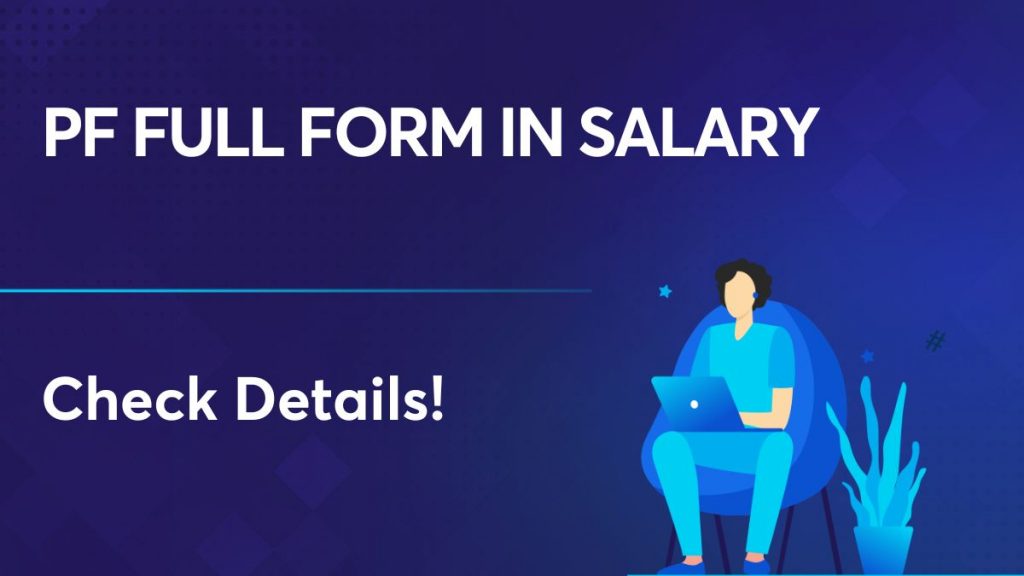In the context of salary, PF Full Form in Salary is Provident Fund. Provident Fund is a retirement savings scheme, which is compulsory for all employees in India who earn less than a certain salary threshold. In this article, we will discuss the concept of the Provident Fund, its features, benefits, and how it impacts an employee’s salary.
PF Full Form in Salary: What is PF?
Provident Fund is a retirement savings scheme, which is mandatory for all employees in India earning up to a certain salary threshold. It is a government-managed scheme that provides financial security to employees after retirement. Provident Fund contributions are made by both the employee and the employer, and the funds are managed by the Employees’ Provident Fund Organisation (EPFO).
Read on SSC Full Form in GD
PF Full Form in Salary: Features of Provident Fund
Here are some of the key features of the Provident Fund:
- Mandatory: Provident Fund is mandatory for all employees in India earning up to a certain salary threshold. The employer must contribute an amount equal to 12% of the employee’s basic salary to the Provident Fund, while the employee must contribute an equal amount.
- Tax Benefits: The contributions made by the employee and employer towards the Provident Fund are eligible for tax deductions under Section 80C of the Income Tax Act. The interest earned on Provident Fund contributions is also tax-free.
- Withdrawal: Employees can withdraw their Provident Fund contributions after a certain period of time, subject to certain conditions. In case of premature withdrawal, taxes may be applicable.
- Interest Rate: The interest rate on Provident Fund contributions is determined by the government and is subject to change from time to time. The current interest rate for Provident Fund is 8.5% per annum.
- Portability: Provident Fund accounts are portable, which means that employees can transfer their accounts when they change jobs.
Read on VLDA Full Form
PF Full Form in Salary: Benefits of PF
Here are some of the key benefits of the Provident Fund:
- Retirement Savings: Provident Fund is a retirement savings scheme that helps employees build a corpus for their retirement.
- Tax Savings: The contributions made by the employee and employer towards the Provident Fund are eligible for tax deductions under Section 80C of the Income Tax Act. The interest earned on Provident Fund contributions is also tax-free.
- Financial Security: Provident Fund provides financial security to employees after retirement. The funds can be used to meet the employee’s financial needs in their golden years.
- Disciplined Saving: Provident Fund helps employees develop a habit of disciplined saving, which can be useful in other areas of their financial planning.
Impact on Employee’s Salary
Provident Fund contributions are deducted from an employee’s salary every month. The employee’s share of the contribution is deducted from their basic salary, while the employer’s share is an additional cost for the employer. Here is an example to illustrate how Provident Fund impacts an employee’s salary:
Let’s assume that an employee earns a basic salary of Rs. 30,000 per month and the employer contributes an amount equal to 12% of the employee’s basic salary to the Provident Fund. In this case, the monthly contribution to Provident Fund would be:
Employee’s contribution = 12% of Rs. 30,000 = Rs. 3,600
Employer’s contribution = 12% of Rs. 30,000 = Rs. 3,600
Total monthly contribution to Provident Fund = Rs. 7,200
In this case, the employee’s take-home salary would be Rs. 30,000 – Rs. 3,600 = Rs. 26,400. The employer’s cost for the employee would be Rs. 30,000 + Rs. 3,600 = Rs. 33,600.
For example, look at the following table to know about the PF.
| Particulars | Amount |
| Employee’s Basic Salary | Rs. 30,000 |
| Employee’s Contribution to Provident Fund (@12% of Basic Salary) | Rs. 3,600 |
| Employer’s Contribution to Provident Fund (@12% of Basic Salary) | Rs. 3,600 |
| Total Monthly Contribution to Provident Fund | Rs. 7,200 |
| Employee’s Take-home Salary | Rs. 26,400 |
| Employer’s Cost for the Employee | Rs. 33,600 |
As you can see from the table, Provident Fund contributions reduce an employee’s take-home salary. However, this reduction is offset by the fact that the contributions are eligible for tax deductions and earn tax-free interest, which can help employees save on taxes and build a retirement corpus.
Read on SCVT Full Form
PF Full Form in Salary: How to Check PF Balance
Here are the step-by-step instructions to check your Provident Fund (PF) balance online:
STEP 1: Visit the EPFO website (www.epfindia.gov.in) or download the EPFO app from the Google Play Store or Apple App Store.
STEP 2: Login using your Universal Account Number (UAN) and password. If you haven’t registered yet, click on the “Activate UAN” option on the EPFO website and follow the instructions.
STEP 3: Once you have logged in, click on the “View Passbook” option.
STEP 4: Select the member ID of the Provident Fund account for which you want to check the balance.
STEP 5: Your PF account details and balance will be displayed on the screen
PF Full Form in Salary: FAQs
The full form of PF in salary is Provident Fund.
Yes, Provident Fund is mandatory for all employees in India earning up to a certain salary threshold.
Provident Fund contributions are eligible for tax deductions under Section 80C of the Income Tax Act, and the interest earned is also tax-free.
The interest rate on Provident Fund contributions is determined by the government and is currently 8.5% per annum.
We have provided in the above article. Kindly check!
